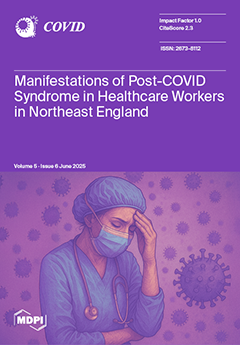Endotheliopathy plays an essential role in the pathophysiology of COVID-19. The endothelial activation and stress index (EASIX) indicates endothelial dysfunction. We aimed to investigate the relationship between a high EASIX score and mortality in patients with COVID-19. We retrospectively reviewed COVID-19 patients admitted to the ICU (intensive care unit) of the Ankara Bilkent City Hospital. We recorded hematological and biochemical parameters at the ICU admission and further calculated EASIX with the following equation: EASIX = Lactate dehydrogenase (U/L) × creatinine (mg/dL)/platelet count (10
9/L). Statistical comparisons were made between the surviving and non-surviving groups in terms of EASIX. The median EASIX score was 1.2 (0.7–2.0) in the survivor group and a median of 2.5 (1.6–4.2) in the non-survivor group (
p < 0.001). The mean log2-EASIX was 0.2 ± 0.9 in the survivor group and 1.3 ± 1.2 in the non-survivor group (
p < 0.001). Lactate dehydrogenase, creatinine, Troponin I, D-dimer, procalcitonin, ferritin, and IL-6 were statistically significantly higher in the non-survivor group compared to the survivor group. The receiver operating characteristic (ROC) curve analysis showed that the cut-off value of the EASIX score was 2.05 (The area under the curve [AUC] = 0.764,
p = 0.001, 95% CI: 0.662–0.847). Our study showed an association between high EASIX scores and poor prognosis in COVID-19 patients. Lactate dehydrogenase, creatinine, Troponin I, D-dimer, procalcitonin, ferritin, IL-6, EASIX, and log2-EASIX were statistically significantly higher in the non-survivor group compared to the survivor group. Being old and having chronic kidney disease increases the risk of death. Eventually, EASIX can be used to predict mortality in COVID-19 patients.
Full article





